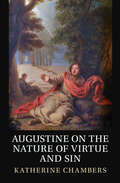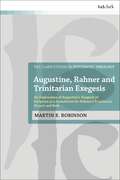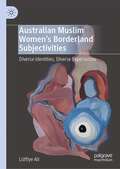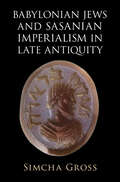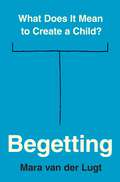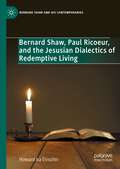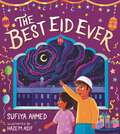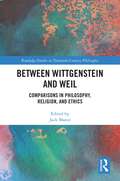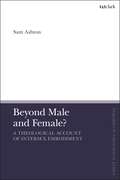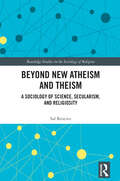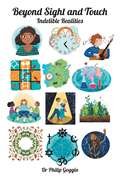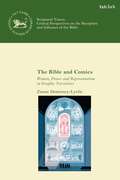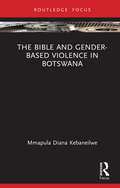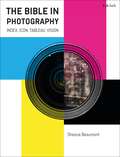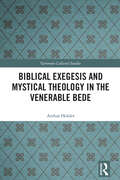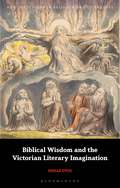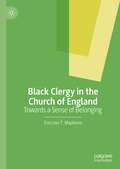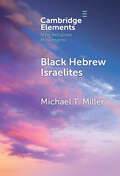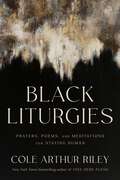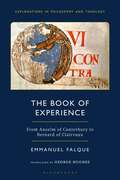- Table View
- List View
Augustine on the Nature of Virtue and Sin
by null Katherine ChambersAugustine of Hippo is a key figure in the history of Christianity and has had a profound impact on the course of western moral and political thought. Katherine Chambers here explores a neglected topic in Augustinian studies by offering a systematic account of the meaning that Augustine gave to the notions of virtue, vice and sin. Countering the view that he broke with classical eudaimonism, she demonstrates that Augustine's moral thought builds on the dominant approach to ethics in classical 'pagan' antiquity. A critical appraisal of this tradition reveals that Augustine remained faithful to the eudaimonist approach to ethics. Chambers also refutes the view that Augustine was a political pessimist or realist, showing that it is based upon a misunderstanding of Augustine's ideas about the virtue of justice. Providing a coherent account of key features in Augustine's ethics, her study invites a new and fresh evaluation of his influence on western moral and political thought.
Augustine, Rahner, and Trinitarian Exegesis: An Exploration of Augustine's Exegesis of Scripture as a Foundation for Rahner's Trinitarian Project and Rule (T&T Clark Studies in Systematic Theology)
by Rev Dr Martin E. RobinsonThrough close and sustained analysis of Augustine's exegesis of Scripture, Robinson argues that Augustine's Trinitarian exegesis offers significant-though not inexhaustible-support for Rahner's Trinitarian project and, particularly, his Grundaxiom. Firstly, he posits that Augustine provides weighty, biblically rich, support for Rahner's Trinitarian agenda at exactly those points where Rahner is explicitly critical of Augustine and the “Augustinian-Western tradition”, overcoming various weaknesses detected in the later tradition, and pre-empting many of Rahner's later solutions. Secondly and consequently, Robinson suggests that Augustine offers a scriptural reading strategy that addresses the major exegetical difficulties perceived to emerge from Rahner's Rule. Thus, in Augustine's exegesis of Scripture, the Augustinian-Western tradition has always had the resources at its disposal to avoid or address the most poignant criticisms levelled both by and at Rahner.
Australian Muslim Women’s Borderland Subjectivities: Diverse Identities, Diverse Experiences
by Lütfiye AliThis book claims a discursive space in academic scholarship for knowledges and ways of knowing that capture the diversity, complexity and full humanness of Australian Muslim women’s subjectivities. It draws on in-depth conversational interviews with 20 Australian Muslim women from various ethnic backgrounds during which the women shared their experiences of being at the crossroads of their religious, gendered, racialised and ethnic identities. The book puts forward a decolonial feminist border methodology by weaving the work of decolonial feminist philosophers Maria Lugones and Gloria Anzaldúa with postmodern feminist thinking on subjectivity and with discourse analysis. This methodology is used to centre and attend to the fluidity and plurality of Muslim women’s subjectivities, at the intersections of race, ethnicity, patriarchy, gender, sexuality and Islam.
Babylonian Jews and Sasanian Imperialism in Late Antiquity
by null Simcha GrossFrom the image offered by the Babylonian Talmud, Jewish elites were deeply embedded within the Sasanian Empire (224-651 CE). The Talmud is replete with stories and discussions that feature Sasanian kings, Zoroastrian magi, fire temples, imperial administrators, Sasanian laws, Persian customs, and more quotidian details of Jewish life. Yet, in the scholarly literature on the Babylonian Talmud and the Jews of Babylonia , the Sasanian Empire has served as a backdrop to a decidedly parochial Jewish story, having little if any direct impact on Babylonian Jewish life and especially the rabbis. Babylonian Jews and Sasanian Imperialism in Late Antiquity advances a radically different understanding of Babylonian Jewish history and Sasanian rule. Building upon recent scholarship, Simcha Gross portrays a more immanent model of Sasanian rule, within and against which Jews invariably positioned and defined themselves. Babylonian Jews realized their traditions, teachings, and social position within the political, social, religious, and cultural conditions generated by Sasanian rule.
Begetting: What Does It Mean to Create a Child?
by Mara van der LugtAn investigation of what it means to have children—morally, philosophically and emotionally&“Do you want to have children?&” is a question we routinely ask each other. But what does it mean to create a child? Is this decision always justified? Does anyone really have the moral right to create another person? In Begetting, Mara van der Lugt attempts to fill in the moral background of procreation. Drawing on both philosophy and popular culture, van der Lugt does not provide a definitive answer on the morality of having a child; instead, she helps us find the right questions to ask.Most of the time, when we talk about whether to have children, what we are really talking about is whether we want to have children. Van der Lugt shows why this is not enough. To consider having children, she argues, is to interrogate our own responsibility and commitments, morally and philosophically and also personally. What does it mean to bring a new creature into the world, to decide to perform an act of creation? What does it mean to make the decision that life is worth living on behalf of a person who cannot be consulted? These questions are part of a conversation we should have started long ago. Van der Lugt does not ignore the problematic aspects of procreation—ethical, environmental and otherwise. But she also acknowledges the depth and complexity of the intensely human desire to have a child of our own blood and our own making.
Begetting: What Does It Mean to Create a Child?
by Mara van der LugtAn investigation of what it means to have children—morally, philosophically and emotionally&“Do you want to have children?&” is a question we routinely ask each other. But what does it mean to create a child? Is this decision always justified? Does anyone really have the moral right to create another person? In Begetting, Mara van der Lugt attempts to fill in the moral background of procreation. Drawing on both philosophy and popular culture, van der Lugt does not provide a definitive answer on the morality of having a child; instead, she helps us find the right questions to ask.Most of the time, when we talk about whether to have children, what we are really talking about is whether we want to have children. Van der Lugt shows why this is not enough. To consider having children, she argues, is to interrogate our own responsibility and commitments, morally and philosophically and also personally. What does it mean to bring a new creature into the world, to decide to perform an act of creation? What does it mean to make the decision that life is worth living on behalf of a person who cannot be consulted? These questions are part of a conversation we should have started long ago. Van der Lugt does not ignore the problematic aspects of procreation—ethical, environmental and otherwise. But she also acknowledges the depth and complexity of the intensely human desire to have a child of our own blood and our own making.
Bernard Shaw, Paul Ricoeur, and the Jesusian Dialectics of Redemptive Living (Bernard Shaw and His Contemporaries)
by Howard Ira EinsohnThis book explores a heretofore unremarked linkage between Bernard Shaw, the twentieth-century French thinker Paul Ricoeur, and Jesus of Nazareth. The ties that bind them are a foundational interest in the social teachings of the Nazarene and their use of a shared dialectics with respect to living the kind of compassionate life that holds out the promise in our contemporary world of achieving something approximating universal wellness on a healthy planet at peace with itself. This work argues that the three principal subjects of the study—independently of one another—used the same dialectical method to reach the same dialectically derived conclusion about how humans can live redemptively in a fractured world.
The Best Eid Ever
by Ms Sufiya AhmedA gorgeous picture book to introduce children to Ramadan and Eid al-Fitr written by acclaimed children's author Sufiya Ahmed with beautiful, colourful illustrations by Hazem Asif.Eid al-Fitr is Aisha's favourite festival and this year her family have promised her and her brother an epic treasure hunt to find their gifts. But between all the chaos and celebrations, will Aisha ever get her presents? From breaking fast to going to the mosque, painting your hands with henna to sharing tasty treats, Aisha's story is the ideal introduction to explore the story of Eid with your children, family or pupils and would make a beautiful gift for Eid.Featuring gorgeous colour illustrations, a non-fiction section with Eid facts, a glossary of key vocabulary, and an accessible story, this stunning picture book is a must have for every child's bookshelf.
Between Wittgenstein and Weil: Comparisons in Philosophy, Religion, and Ethics (Routledge Studies in Twentieth-Century Philosophy)
This volume explores the relationship between the philosophical thought of Simone Weil and Ludwig Wittgenstein. The contributions shed light on how reading Weil can inform our understanding of Wittgenstein, and vice versa. The chapters cover different aspects of Weil’s and Wittgenstein’s philosophy, including their religious thought and their views on ethics and metaphilosophy. They address the following questions: How does Wittgenstein’s struggle with religious belief match up with Simone Weil’s own struggle with organised belief? What is the role of the mystical and supernatural in their works? How much impact has various posthumous editorial decisions had on the shaping of Weil’s and Wittgenstein’s thought? Is there any significance to similarities in Weil’s and Wittgenstein’s written and philosophical styles? How do Weil and Wittgenstein conceive of the ‘self’ and its role in philosophical thinking? What role does belief play in Weil’s and Wittgenstein’s respective philosophical works? Between Wittgenstein and Weil will be of interest to scholars and advanced students working in twentieth-century philosophy, philosophy of religion, philosophy of language, and the history of moral philosophy.
Between Wittgenstein and Weil: Comparisons in Philosophy, Religion, and Ethics (Routledge Studies in Twentieth-Century Philosophy)
by Jack ManziThis volume explores the relationship between the philosophical thought of Simone Weil and Ludwig Wittgenstein. The contributions shed light on how reading Weil can inform our understanding of Wittgenstein, and vice versa. The chapters cover different aspects of Weil’s and Wittgenstein’s philosophy, including their religious thought and their views on ethics and metaphilosophy. They address the following questions: How does Wittgenstein’s struggle with religious belief match up with Simone Weil’s own struggle with organised belief? What is the role of the mystical and supernatural in their works? How much impact has various posthumous editorial decisions had on the shaping of Weil’s and Wittgenstein’s thought? Is there any significance to similarities in Weil’s and Wittgenstein’s written and philosophical styles? How do Weil and Wittgenstein conceive of the ‘self’ and its role in philosophical thinking? What role does belief play in Weil’s and Wittgenstein’s respective philosophical works? Between Wittgenstein and Weil will be of interest to scholars and advanced students working in twentieth-century philosophy, philosophy of religion, philosophy of language, and the history of moral philosophy.
Beyond Male and Female? A Theological Account of Intersex Embodiment (T&T Clark Enquiries in Theological Ethics)
by Revd Dr Sam AshtonIn this incisive work, Sam Ashton provides a compelling, consistent and erudite argument for a foundational approach to the matter of sexual difference, drawing on biblical and doctrinal material and using resources in their original languages. He tracks and traces the sexed body as it moves from creation, through the fall, to redemption “now,” and final consummation “not yet.” In doing so, Ashton presents what is perhaps the strongest case that can be made for 'male and female He created them'.Each chapter privileges biblical exegesis, drawing upon figures in church history (notably Augustine and Aquinas) as and when they illumine Scripture. By doing so, the book considers the difficulty presented to sexual dimorphism by the phenomenon of intersex. Ashton seeks to develop an understanding that is generous, inclusive and affirming, so he works carefully through the writings of Thatcher, Song and Cornwall in a way that invites engagement and dialogue.With the complete divine drama in view, the book offers synthetic judgments about what remains essential for the “structure” of the sexed body as it travels through history and what may be accidental to the sexed body's “direction” within a particular theo-dramatic act. Ashton concludes by considering ways to transition from dogmatic judgments about intersexuality to the moral-pastoral care of concrete intersex individuals, briefly thinking about the complex matter of marriage.
Beyond New Atheism and Theism: A Sociology of Science, Secularism, and Religiosity (Routledge Studies in the Sociology of Religion)
by Sal RestivoThis book addresses the flaws and fallacies in the grounds for atheism and theism – flaws and fallacies that contaminate the arguments of non-believers and believers alike. Focusing on the highly visible debates between the New Atheists – such as Christopher Hitchens, Daniel Dennett, Richard Dawkins, and Sam Harris on the one hand – and their main theist opponents – including Frank Turek, John Lennox, and William Lane Craig on the other – it approaches these debates from the perspective of the sociology of religion and science. With entire worldviews at stake, it explores various failings in the logic, language, and knowledge of the protagonists, revealing mistaken and oversimplified understandings of both science itself and the sociocultural and symbolic roles of religion on both sides. Advancing a secular and humanist worldview unburdened by the problems that beset both atheism and theism, the author argues for a sociological perspective on religion, God, and science as a practice, together with a critical realist approach to the nature of the real world as we experience it. Beyond New Atheism and Theism will therefore appeal to scholars and students of sociology and cultural studies with interests in the conflicting worldviews of science and religion.
Beyond New Atheism and Theism: A Sociology of Science, Secularism, and Religiosity (Routledge Studies in the Sociology of Religion)
by Sal RestivoThis book addresses the flaws and fallacies in the grounds for atheism and theism – flaws and fallacies that contaminate the arguments of non-believers and believers alike. Focusing on the highly visible debates between the New Atheists – such as Christopher Hitchens, Daniel Dennett, Richard Dawkins, and Sam Harris on the one hand – and their main theist opponents – including Frank Turek, John Lennox, and William Lane Craig on the other – it approaches these debates from the perspective of the sociology of religion and science. With entire worldviews at stake, it explores various failings in the logic, language, and knowledge of the protagonists, revealing mistaken and oversimplified understandings of both science itself and the sociocultural and symbolic roles of religion on both sides. Advancing a secular and humanist worldview unburdened by the problems that beset both atheism and theism, the author argues for a sociological perspective on religion, God, and science as a practice, together with a critical realist approach to the nature of the real world as we experience it. Beyond New Atheism and Theism will therefore appeal to scholars and students of sociology and cultural studies with interests in the conflicting worldviews of science and religion.
Beyond sight and touch: indelible realities
by Philip GogginMuch of the language of our cultural lives assumes the existence of realities which we cannot see or touch. Mathematical rules, such as the principles of addition or subtraction, are examples of such unseen realities. But so are very many further concepts - such as nature or beauty. You can see and touch instances of nature or beauty, but you can't touch nature or beauty themselves. These concepts endure beyond the particular examples. This short book discusses, in a non-academic way, various aspects of human experience - music, ritual, place, love for instance - to identify such timeless aspects. The very nature of our minds suggests a timeless dimension. Supernatural or psychic phenomena are not the focus, though their existence is not ruled out. Thus it offers fruitful and accessible ways of considering enduring aspects of our human experiences. Here you will find a refreshing and heartening way of thinking about life: the places and things we value, our relationships, our losses and bereavements, and our futures. If you have ever wondered if events or places or experiences or people can have an existence beyond what you can see or touch, this book will be of interest to you. Even if you are a very down-to-earth person who is only concerned with what can be measured or proved, you will find here ideas to challenge.
The Bible and Comics: Women, Power and Representation in Graphic Narratives (The Library of Hebrew Bible/Old Testament Studies)
by Dr. Zanne Domoney-LyttleThis interdisciplinary volume seeks to trace the diverse ways in which stories of biblical women have been reimagined in and as comic books. Feminist biblical scholarship has previously addressed the tradition that relegates female biblical characters to secondary roles, merely enabling the male characters to attain their own goals. Using examples from both secular and religious comic Bibles, and comic Bibles aimed at children and older audiences, Zanne Domoney-Lyttle now fully considers contemporary remediations of biblical narratives to the same degree. Remediating ancient, biblical text into modern, graphical comic books affects the reception of the text in several ways. This book aims to investigate how the production, format, and function of comic Bibles encourages the depiction of biblical characters from a contemporary perspective, while also showing some fidelity to the text. By presenting a focused analysis on women in the Bible, wider issues concerning popular-cultural retellings of the Bible in general begin to surface, including matters concerning reception history, the space between art and literature inhabited by biblical comics, and issues of translation and interpretations within contemporary remediations.
The Bible and Gender-based Violence in Botswana (ISSN)
by Mmapula Diana KebaneilweThe Bible and Gender-based Violence in Botswana foregrounds the rampancy of gender-based violence against women and girls in biblical texts and how it resonates with gender-based violence (GBV) in the author’s contemporary context of Botswana.The volume reads selected texts from the Bible alongside newspaper reports of GBV against women and girls in Botswana to show that while the Bible is taken as an authoritative text within the Botswana context, it is riddled with GBV against female persons. It asserts that by acknowledging and naming GBV in biblical texts and not concealing, ignoring, or spiritualizing it, contemporary communities of faith will be able to confront the problem in these contexts. By so doing, the book argues, the Bible will become a resource for positive transformation rather than a tool for supporting gender injustice.The book appeals to everyone willing to see positive change in regard to gender in/equality and is intended for a wide readership including researchers, postgraduates, church and other representatives of religious institutions, and upper-level undergraduates.
The Bible and Gender-based Violence in Botswana (ISSN)
by Mmapula Diana KebaneilweThe Bible and Gender-based Violence in Botswana foregrounds the rampancy of gender-based violence against women and girls in biblical texts and how it resonates with gender-based violence (GBV) in the author’s contemporary context of Botswana.The volume reads selected texts from the Bible alongside newspaper reports of GBV against women and girls in Botswana to show that while the Bible is taken as an authoritative text within the Botswana context, it is riddled with GBV against female persons. It asserts that by acknowledging and naming GBV in biblical texts and not concealing, ignoring, or spiritualizing it, contemporary communities of faith will be able to confront the problem in these contexts. By so doing, the book argues, the Bible will become a resource for positive transformation rather than a tool for supporting gender injustice.The book appeals to everyone willing to see positive change in regard to gender in/equality and is intended for a wide readership including researchers, postgraduates, church and other representatives of religious institutions, and upper-level undergraduates.
The Bible in Photography: Index, Icon, Tableau, Vision (Scriptural Traces)
by Dr. Sheona BeaumontSheona Beaumont addresses the untold story of biblical subjects in photography. She argues that stories, characters, and symbols from the Bible are found to pervade photographic practices and ideas, across the worlds of advertising and reportage, the book and the gallery, in theoretical discourse and in the words of photographers themselves. Beaumont engages interpretative tools from biblical reception studies, art history, and visual culture criticism in order to present four terms for describing photography's latent spirituality: the index, the icon, the tableau, and the vision. Throughout her journey she includes lively discussion of selected fine art photography dealing with the Bible in surprising ways, from images by William Henry Fox Talbot in the 19th century to David Mach in the 21st. Far from telling a secular story, photography and the conditions of its representations are exposed in theological depth.; Beaumont skillfully interweaves discussion of the images and theology, arguing for the dynamic and potent voice of the Bible in photography and enriching visual culture criticism with a renewed religious understanding.
Biblical Exegesis and Mystical Theology in the Venerable Bede (Variorum Collected Studies)
by Arthur HolderBiblical Exegesis and Mystical Theology in the Venerable Bede brings together 17 essays by Arthur Holder exploring the theology and spirituality found in Bede’s biblical commentaries and homilies. The volume shows that Bede was both a masterful student of received tradition and a creative thinker concerned to address the needs and interests of his audience of Christian pastors and teachers in the eighth-century Northumbrian church.Although Bede is best known as the author of The Ecclesiastical History of the English People, the last half-century of scholarship has demonstrated the sophistication and vast influence of his work in the fields of grammar, biblical interpretation, hagiography, poetry, computus, natural science, and theology. The chapters in this volume show how Bede’s exegesis was integrally connected with his work in all those genres and with the monumental artistic productions of his monastery such as the illuminated bible manuscript known as the Codex Amiatinus. The five parts of the book deal with Bede as teacher and biblical scholar, his interpretations of the tabernacle and the temple, his commentary on the Song of Songs, his attitudes toward philosophy and heresy, and his mystical theology.This book will be of interest to students of Christian theology, mysticism, the development of biblical interpretation, and the history of early medieval England.
Biblical Exegesis and Mystical Theology in the Venerable Bede (Variorum Collected Studies)
by Arthur HolderBiblical Exegesis and Mystical Theology in the Venerable Bede brings together 17 essays by Arthur Holder exploring the theology and spirituality found in Bede’s biblical commentaries and homilies. The volume shows that Bede was both a masterful student of received tradition and a creative thinker concerned to address the needs and interests of his audience of Christian pastors and teachers in the eighth-century Northumbrian church.Although Bede is best known as the author of The Ecclesiastical History of the English People, the last half-century of scholarship has demonstrated the sophistication and vast influence of his work in the fields of grammar, biblical interpretation, hagiography, poetry, computus, natural science, and theology. The chapters in this volume show how Bede’s exegesis was integrally connected with his work in all those genres and with the monumental artistic productions of his monastery such as the illuminated bible manuscript known as the Codex Amiatinus. The five parts of the book deal with Bede as teacher and biblical scholar, his interpretations of the tabernacle and the temple, his commentary on the Song of Songs, his attitudes toward philosophy and heresy, and his mystical theology.This book will be of interest to students of Christian theology, mysticism, the development of biblical interpretation, and the history of early medieval England.
Biblical Wisdom and the Victorian Literary Imagination (New Directions in Religion and Literature)
by Denae DyckExamining the creative thought that arose in response to 19th-century religious controversies, this book demonstrates that the pressures exerted by historical methods of biblical scholarship prompted an imaginative recovery of wisdom literature.During the Victorian period, new approaches to the interpretation of sacred texts called into question traditional ideas about biblical inspiration, motivating literary transformations of inherited symbols, metaphors, and forms. Drawing on the theoretical work of Paul Ricoeur, Denae Dyck considers how Victorian writers from a variety of belief positions used wisdom literature to reframe their experiences of questioning, doubt, and uncertainty: Elizabeth Barrett Browning, George MacDonald, George Eliot, John Ruskin, and Olive Schreiner. This study contributes to the reassessment of historical and contemporary narratives of secularization by calling attention to wisdom literature as a vital, distinctive genre that animated the search for meaning within an increasingly ideologically diverse world.
Black Clergy in the Church of England: Towards a Sense of Belonging
by Ericcson T. MapfumoThis book explores the experiences of ordinands and Black clergy of the Church of England (CofE). An increasing number of Black ordinands (trainees) from African and Caribbean heritages are choosing a ministerial pathway in the Anglican Communion, which has necessitated insights which recognise what they have to bring from their place of origin. Accounts of some of their relationships in the Church of England have been documented and reports on the issues and challenges of institutionalised racism. Anecdotal reference also suggests that the CofE has become a White institution which has not supported its Black clergy in their ministry. The purpose of this book is to present the lived experience of Black clergy in the Church of England, while highlighting some of the challenges they face and to offer solutions to make the church anti-racist.
Black Hebrew Israelites (Elements in New Religious Movements)
by null Michael T. MillerThe Black Hebrew Israelite movement claims that African Americans are descendants of the Ancient Israelites and has slowly become a significant force in African American religion. This Element provides a general overview of the BHI movement, its diverse history/ies, ideologies, and practices. The Element shows how different factions and trends have taken the forefront at different periods over its 140-year history, leading to the current situation where diverse iterations of the movement exist alongside each other, sharing some core concepts while differing widely. In particular, the questions of how and why BHI has become a potent and attractive movement in recent years are addressed, arguing that it fulfils a specific religious need to do with identity and teleology, and represents a new and persistent form of Abrahamic religion.
Black Liturgies: Prayers, poems and meditations for staying human
by Cole Arthur RileyIn the summer of 2020, Cole Arthur Riley was desperate for a spirituality she could trust. Amidst ongoing national racial violence, the isolation of the pandemic, and a surge of anti-Black rhetoric in many Christian spaces, she began dreaming of a harbour for a more human, more liberating expression of faith. She went on to create Black Liturgies, a digital project that connects spiritual practice with Black emotion, memory, and the Black body.In this book, she deepens the work of that project, bringing together new prayers, letters, poetry, meditation questions, breath practice, and the writings of Black literary ancestors to offer 43 liturgies that can be practised individually or as a community. With a poet's touch and a sensitivity that has made her one of the most important spiritual voices at work today, Riley invites readers to reflect on their own experiences of wonder, rest, rage, and repair, while also including liturgies for holidays like Lent, Advent and Mother's Day.For those healing from spiritual spaces that were more violent than loving; for those who have escaped the trauma of white Christian nationalism, religious homophobia, and transphobia; for anyone asking what it means to be human in a world of both beauty and terror; Black Liturgies is a work of healing and liberation, and a vision for what might be.
The Book of Experience: From Anselm of Canterbury to Bernard of Clairvaux (Explorations in Philosophy and Theology)
by Emmanuel FalqueEmmanuel Falque, one of the foremost philosophers working in the continental philosophy of religion today, takes us by the hand into the very heart of 12th-century monastic spirituality.Translated into English for the first time, The Book of Experience weaves together contemporary phenomenological questions with medieval theology, revealing undiscovered dialogues already underway between Hugh of St. Victor and Maurice Merleau-Ponty, between Richard of St. Victor and Emmanuel Levinas, between Aelred of Rievaulx and Michel Henry, and not least between Bernard of Clairvaux and the trio of Descartes, Heidegger, and Jean-Luc Marion, consummating in a masterful phenomenological reading of Bernard's sermons on the Song of Songs. Whether it is a question of 'the idea that comes to God' (Anselm of Canterbury) or actively 'feeling oneself fully alive' (Aelred of Rievaulx or Bernard of Clairvaux), Falque uses these encounters to shed light on both parties, medieval and modern, theological and philosophical. Leading us through works of art, landscapes, architectures, and liturgies, this major contemporary philosopher of religion clarifies mysteries and discovers experience lying at the heart of the medieval tradition.
